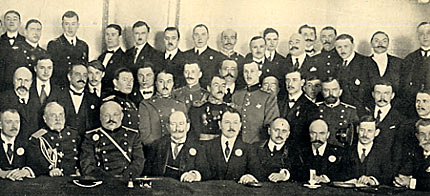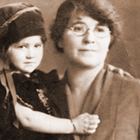Rob Moshein has written an excellent article on the challenges of finding Jewish ancestors and creating your own family tree.

- A Scotman in Russia
- The First Steps
- Russian Military Flying Schools
- The Imperial All Russia Aero Club
- General Baron Kulbars & Aviation
- The Imperial Russian Technical Society
- The Prototype of the Zeppelin
- Contruction, Aviators & Workmen
- Famous Russian Flying Men
- I.I. Sikorsky
- Foriegn Aviators in Russia
- Heir Fokker's Russian Lady Pilot
- Just Before the War
- Aerial Russia & the British Press
- Aviation & the Russian Press
- By Way of Conclusion

Chapter IV - The Imperial All Russia Aero Club
Russia has for years had an all-round admiration for the sporting life of Great Britain, and she has created many clubs on British lines for the improvement and development of Russian sport. The Imperial All Russia Aero Club was founded in 1908 by a few members of the Russian aristocracy, who were interested in aviation from a purely patriotic point of view. The Aero Club soon became a popular institution, and it has certainly played a most important part in the progress of Russian aviation. It owed its initiation principally to the world-famous Russian General Baron A. Kaulbars, and its first president was the well-known millionaire, Count Stenbok-Fermor. At the beginning the Club was mostly occupied in experimenting with balloons and box kites. The balloons, "Vasily Korn" and "Count Rostovtzeff," made several interesting flights under the pilotage of Ulianin, Sredinsky, and Kuznetzoff. Members of the Russian Flying Corps were interested in the Club, among them the famous Captain Shabsky. The Aero Club indeed succeeded in uniting, through their common interests, the civilian and the military airmen.

In 1909 the Club began to pay serious and persistent attention to the aeroplane. It sent Mr. Raievsky, Mr. Sredinsky, and Mr. Lebedeft to Paris to study the developments of aviation in France, and the result of this visit \vas the opening of the Club's Flying School. In those days it had no aerodrome of its own, and it hired a field from the Wing Company, the chairman of which was Mr. Boris Somorine, the son of the editor of the Novoie Vremya. The school, which was directed by Sredinsky, had at first little success. Sredinsky himself was a good aeronaut and an experienced balloon pilot. He flew in aeroplanes with courage and enterprise, but he was never able to land safely, and he contrived to smash up all the machines he used.
The Aero Club's first contests were organised in 1910 with a flight from Petrograd to Moscow. Mr. Wassilieff reached the ancient Russian capital (603 versts) in the same day, and won the prize. Another competitor, Mr. Slessarenko, had a bad fall, severely injured himself, and killed his passenger, and none of the others succeeded in reaching the goal.
With the assistance of private capitalists the Aero Club also began in 1910 the organisation of "aviation weeks," during which for the first time in Russia military aviators were allowed to fly before the public. In these early days the few companies formed to build aeroplanes were almost bankrupt, and even the Wing Company, despite the fact that its chairman was of a rich family, was on the point of collapse. In order to keep the aerodrome the Aero Club bought it outright from the Company. The Flying School was reorganised by Mr. Lebedeff, who from that time supplied Russia with a succession of well-trained pilots.
The 1911 Aviation Week ended in disaster. The aeroplane "Sommer," built by the Russo-Baltic Wagon Works, crashed down and its pilot, Mr. Schmidt, was instantly killed. During the same year the Aero Club hangars began to shelter many new machines built by native inventors, and from then until the outbreak of the war new apparatus was constantly tested in the Club's aerodrome.
Since 1910 the Aero Club has made a practice of inviting famous foreign aviators to visit Petrograd. Latham was one of the first visitors, but his flight from the Jockey Club Racecourse was an utter failure. In 1911 Christians, Vincieas, and Morane flew in Petrograd, and they were followed by Bleriot, who lectured and had a most enthusiastic reception.
The success of the Imperial All Russia Aero Club led to the institution of sister clubs in other cities. At first the club depended on the subscriptions of its own members, but in 1911 the Czar granted it permission to open public subscriptions for the creation of a Russian Aerial Fleet, and this permission gave the Club considerable political importance. In a very short time 120,000 was collected, all of which was spent in the construction of aeroplanes, the types including the "Wright," "Curtiss," "Bleriot," "Antoinette," "Pichoff," and" Farman."
Until 1914 the Club was handicapped by the want of good hangars, and in that year the first of these were constructed under the direction of Captain Jatsuk, who had succeeded Lebedeff as Director of the Aviation School. Jatsuk's administration was in every way successful, and it was owing to his efforts that military officers were enabled to obtain their elementary flying education from the Aero Club's instructors.
In 1912 Prince Abamelik-Lazareff offered through the Club a prize of a thousand pounds to any aviator who succeeded in flying from Petrograd to Moscow and back in two days. The competition took place but nobody fulfilled the conditions. Next year the prize was offered again. The conditions were made more severe, the two journeys haying to be completed within twenty-four hours. Wassilief was the only flying man who finished the course, and he was seventeen minutes too late for the thousand pounds.
During these years Sikorski was experimenting with his giant planes on the Club's aerodrome, and a Mr. Steglau was constantly testing a highly interesting type of machine which he had invented, and which was built entirely of wood, even the wings being constructed of three-ply wood instead of fabric. The Steglau machines flew very well. Unfortunately the inventor insisted on flying them himself, and, as he was anything but a good pilot, there occurred a whole series of accidents. Steglau was a large contractor and an important financier and his bankers were naturally keenly interested in his career as an aviator. His death would have meant considerable loss to his financial associates and they read the accounts of his almost daily accidents with apprehension. The banks therefore decided to stop credit and Mr. Steglau was forced to abandon his career as an aeroplane pilot.
Among the Club's members was a young student of eighteen called Porohovstchikoff. This boy built an aeroplane of his own invention and fitted it with a hundred horsepower Gnome engine. His machine was copied by the Germans and they have used it as the model for some of the types of their battle aeroplanes. The distinctive feature of the Porohovstchikoff is its doublc fuselage.
When war broke out the Imperial All Russia Aero Club placed all its pilots at the disposal of the General Staff and they are being maintained in the field at the Club's expense. In addition to this direct help the Club has rendered good service to the Government in the drawing up of new aviation laws. For years it has carried out a sustained , aviation propaganda by means of popular lectures in every part of the Empire. This propaganda has had the happiest results, and in 1914, in spite of the vastness of Russia and the general ignorance of the Russian peasant, there was scarcely a village in the Czar's dominions where the people did not know that men had learned to fly.
When in the early days of the war two Austrian aeroplanes landed in a Russian village, where every man had gone to the front and only women were left a t home, these women met the aerial visitors without any apprehension, captured them and looked after the machines until they were fetched away by the authorities.



